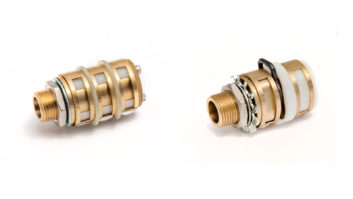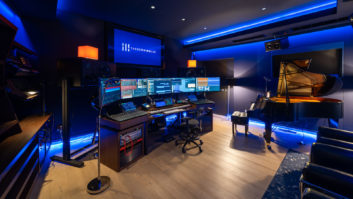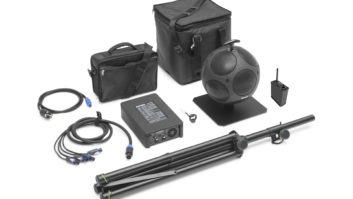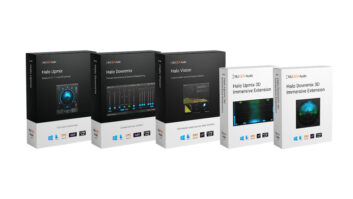PHYSICAL CHARACTERISTICSThe Alesis M1 Active Monitor’s enclosure is a bass reflex design with dual, elbowed ports. The 1.5-inch-diameter ports are flared at the baffle, go into the enclosure 5 inches, take a 90degrees turn, and terminate on a 45degrees slanted cut. This port design technique minimizes bass reflex artifacts. The charcoal-painted baffle is 1-inch-thick MDF. The remainder of the enclosure is 51/48-inch-thick, vinyl-covered MDF, with internal, particle board cleats in all corners. Each enclosure weighs 19.5 pounds, measures 15×8.5×9.75 inches (HxWxD) and is generously stuffed with fiberglass.
The 6.5-inch woofer features a non-woven carbon fiber cone with a Santoprene rubber half-roll surround, a 1.5-inch-diameter voice coil wound on a vented fiberglass bobbin, and a 4-inch-diameter flat spider. The flat outside edge of the spider results in less bass harmonic distortion than a bumped spider. The stamped steel frame is attached to a conventional motor structure using a healthy 4×0.8-inch-thick ceramic magnet, shielded by a bucking magnet on the back side of the bumped T-yoke, providing for extra woofer excursion. Insulated tinsel leads-a good precaution when using an electrically conductive cone-are terminated into polarized 0.205- and 0.110-inch tabs. A decorative, rubber trim ring is placed over the standard pad ring and mounting screws to help reduce reflections off the edge of the woofer frame.
The dome tweeter uses a 1-inch soft, treated cloth dome diaphragm driven by a ferrofluid-cooled, underhung voice coil wound on an aluminum bobbin. Underhung voice coils offer low distortion, more extended top end and more linear phase response. Behind the diaphragm is a hemisphere of felt on top of the pole piece to eliminate cavity resonances behind the diaphragm. The deep countersink on the 3.70-inch-diameter face plate provides good horn loading and directivity control to the tweeter. This waveguide reduces some of the tweeter’s spray onto the mixing board, which tends to bounce up into the face of the recording engineer. The conventional ceramic magnet motor structure is magnetically shielded by both a bucking magnet and shielding can. Electrical termination is provided by dual 0.110-inch tabs.
The bi-amplified active monitor delivers 75 watts to the 6-ohm woofer and 25 watts into the 4-ohm tweeter. Two single-sided circuit boards at right angles to each other comprise the amplifier. A galvanized steel plate shields the board that contains the inductors and transformers. The output devices are mounted on an L-shaped aluminum extrusion that runs the length of the amplifier. The input panel has a Neutrik Combo jack and input level pot.
ACOUSTICAL CHARACTERISTICSThe frequency response of the Alesis M1 Active is very flat. From 100 to 20k Hz, the device is around +/-2.5 dB, with most of the response staying within a 3dB window. Only after 15 kHz is there a 3dB bump of brilliance. Off-axis response (at -30degrees) behaves nicely. After following a flat response to 5 kHz, the remainder of the response drops -9 dB out to 18 kHz on a constant slope.
The transient response is the only questionable attribute of this product. The impulse is damped and exhibits good decay, but the path it takes to get there isn’t textbook. The shape of the decay reveals at least two irregular notches, one centered at 3.6 ms and the other at 4.5 ms. Engineers at Alesis claimed alignment at the crossover region, but possibly due to the eighth order crossover, the phase characteristics are just too difficult to control.
The distortion figures on this monitor are also very good. Except for a couple of data points, the distortion remains under 0.5% past 100 Hz, and under 1% beyond 50 Hz. Only at the 1,500Hz crossover point does the distortion begin to act up a bit. The second harmonic dominates the third, which will give listeners a warm, fuzzy feeling.
Spectral contamination, which measures the nonharmonic distortion, is good but not great. Most of the peaks (input tones) are 50 dB above the noise floor, but there are a couple of data points at which the noise is only around 40 dB down.







